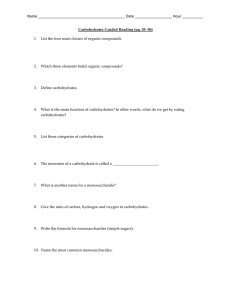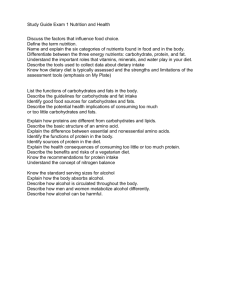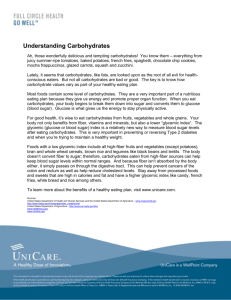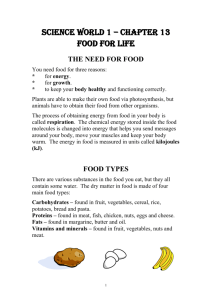Carbohydrates
advertisement
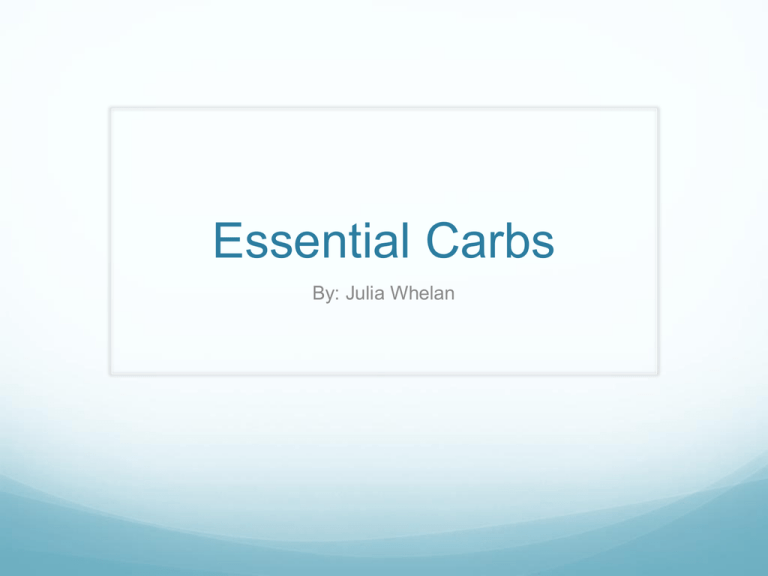
Essential Carbs By: Julia Whelan What is it? Carbohydrates are essential! The body uses carbohydrates to make glucose which is the fuel of our bodies The brain itself uses 130grams/day Where are they? Carbohydrates can be found in: Fruits Vegetables Milk and milk products Breads, cereals, and other grains Foods with added sugars (cakes, candy, etc.) The BIG Difference unrefined vs. refined carbohydrates Unrefined: carbohydrates that are not altered; still in their natural state Sources Refined: carbohydrates that have been processed and stripped of nutrients Sources Unrefined Carbohydrates It’s the whole package! Whole grains Legumes Vegetables Fruits Milk and milk products Refined Carbohydrates Baked goods Sodas Processed foods White breads Fruit juices Refined Carbohydrates = Empty Calories Adding calories but little nutrients How do they refine a grain? The Fiber One of the many benefits of eating unrefined whole grains! A diet high in fiber has been shown to: Reduce blood cholesterol levels Reduce blood pressure Promote a healthy colon Control blood sugars The Fiber Types Soluble fiber- fiber that dissolves in water forming a viscous solution Oats, apples, beans, flaxseeds, pears, carrots Insoluble fiber- fiber that does not dissolve in water and cannot be broken down Wheat bran, brown rice, whole wheat, dark leafy vegetables Carbohydrates & Weight Loss It has been shown that diets with adequate unrefined carbohydrates can help make weight loss and weight maintenance easier Include adequate fiber = makes you feel full Carbohydrates themselves are not “fattening”, it’s the stuff we add to them Moderation is Key Anything consumed in excess will add on the pounds Carbohydrates are no more “fattening” than any other nutrient How much should we aim for? Carbohydrates should make up 45-65% of our total calories each day The sources of carbs is most important! Fiber intake should be 25-38 grams per day Mix-it up, balance out soluble and insoluble fibers Sources: Nutrition Science and Applications, 2nd Edition, L. Smolin and M. Grosvenor Nutrition and Healthy Living, Mayo Clinic, http://www.mayoclinic.org/carbohydrates/ART-20045705?p=1 Nutrition for Everyone- Carbohydrates, Center for Disease Control and Prevention, http://www.cdc.gov/nutrition/everyone/basics/carbs.html Choose Carbohydrates Wisely, http://www.csrees.usda.gov/nea/food/pdfs/hhs_facts_carbohydrate s.pdf The danger of a low carbohydrate diet Ketosis- when the body is running low on carbohydrates it cannot make glucose (the fuel) and instead makes ketones Mild ketosis- headache, dry mouth, foul-smelling breath, and a reduced appetite Severe ketosis- increases acidity of the blood and can result in coma and death


